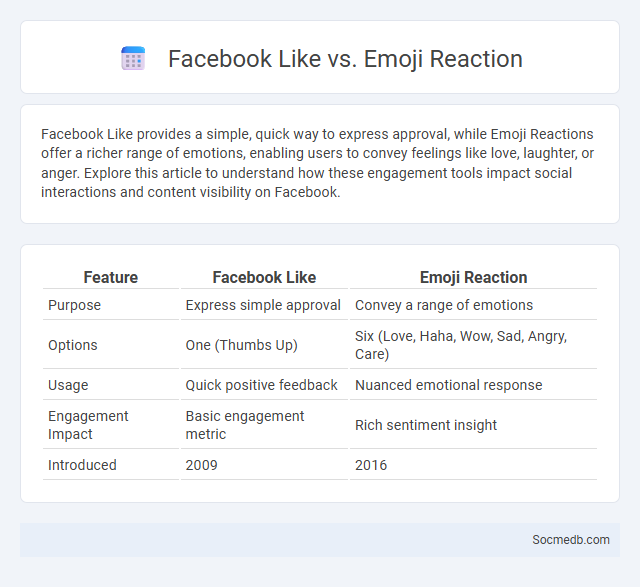
Photo illustration: Facebook Like vs Emoji Reaction
Facebook Like provides a simple, quick way to express approval, while Emoji Reactions offer a richer range of emotions, enabling users to convey feelings like love, laughter, or anger. Explore this article to understand how these engagement tools impact social interactions and content visibility on Facebook.
Table of Comparison
| Feature | Facebook Like | Emoji Reaction |
|---|---|---|
| Purpose | Express simple approval | Convey a range of emotions |
| Options | One (Thumbs Up) | Six (Love, Haha, Wow, Sad, Angry, Care) |
| Usage | Quick positive feedback | Nuanced emotional response |
| Engagement Impact | Basic engagement metric | Rich sentiment insight |
| Introduced | 2009 | 2016 |
Introduction: Understanding Facebook Engagement
Facebook engagement measures user interactions such as likes, comments, shares, and clicks that reflect content relevance and audience interest. High engagement rates indicate effective content strategies and increased brand visibility within Facebook's algorithm. Analyzing engagement metrics enables businesses to tailor posts for improved reach and community building.
What is the Facebook Like?
The Facebook Like is a key engagement feature that allows users to express approval or interest in posts, comments, photos, and videos. It influences content visibility by signaling popularity to Facebook's algorithm, enhancing the reach and interaction potential of shared material. Businesses and creators often track Like metrics to gauge audience engagement and optimize social media strategies.
Evolution: From Like to Emoji Reaction
Social media interaction has evolved from simple "likes" to diverse emoji reactions, enhancing user expression and engagement. Platforms like Facebook introduced emoji reactions in 2016, allowing users to convey emotions such as love, laughter, sadness, and anger with a single click. This shift has enriched communication dynamics, enabling nuanced feedback that goes beyond basic approval metrics.
How Emoji Reactions Work
Emoji reactions enhance your social media interactions by allowing you to express emotions quickly without typing a comment. Platforms like Facebook, Instagram, and Twitter use emoji reactions to help users convey feelings such as love, laughter, or surprise, increasing engagement and communication efficiency. These reactions are processed through simple user interface clicks that instantly update the post's reaction count and display aggregated emoji metrics.
Key Differences Between Like and Emoji Reactions
Like reactions primarily express agreement or approval on social media posts, serving as a quick and straightforward way for users to engage. Emoji reactions offer a broader emotional spectrum, allowing users to convey specific feelings such as sadness, laughter, or anger, enhancing nuanced communication. The use of emoji reactions increases user interaction diversity and provides content creators with detailed feedback on audience sentiment.
User Behavior: Preferences and Trends
User behavior on social media reveals a preference for short-form, visually engaging content like videos and stories, driving platforms to prioritize these formats in their algorithms. Trends indicate a growing demand for authentic interactions, with users favoring real-time engagement through live streams and interactive features such as polls and Q&As. Understanding your unique preferences can help tailor content strategies to maximize reach and foster meaningful connections across social media channels.
Impact on Algorithm and Reach
Social media platforms use complex algorithms that analyze user behavior, engagement patterns, and content relevance to determine the visibility and reach of posts. These algorithms prioritize content that generates higher interaction, such as likes, comments, and shares, significantly impacting organic reach and user exposure. Understanding and adapting to algorithm changes is crucial for maximizing content distribution and audience engagement on platforms like Facebook, Instagram, and TikTok.
Emotional Expression and Communication
Social media platforms enhance emotional expression by providing diverse tools like emojis, GIFs, and videos that help you convey feelings more vividly. These digital spaces facilitate real-time communication, allowing for immediate emotional feedback and stronger interpersonal connections. Understanding how to use these expressive features effectively can improve your online interactions and emotional engagement.
Benefits for Brands and Marketers
Social media enables brands to increase visibility by reaching targeted audiences through precise demographic and interest-based advertising, enhancing customer engagement and loyalty. Your marketing efforts benefit from real-time analytics and feedback, allowing for agile campaign adjustments and improved ROI. Platforms like Instagram, Facebook, and LinkedIn facilitate direct communication with consumers, fostering trust and driving conversion rates effectively.
Conclusion: Choosing the Best Engagement Tool
Selecting the best engagement tool for social media depends on aligning features with your specific audience behavior and content goals. Tools like Hootsuite, Buffer, and Sprout Social offer robust analytics and scheduling capabilities that enhance interaction and streamline management. Your choice directly impacts the efficiency of community building and the depth of insights you can derive from user engagement metrics.
 socmedb.com
socmedb.com